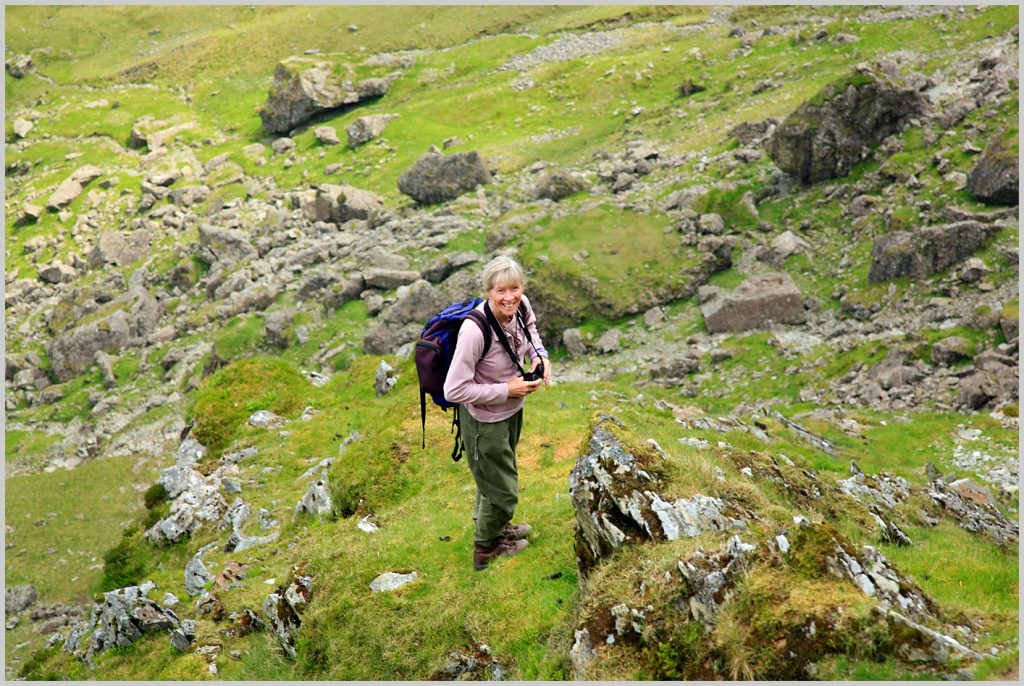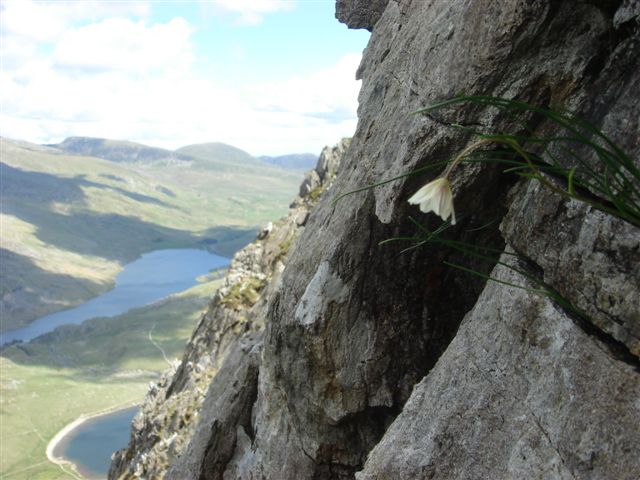
If 2020 is to go down in history as the year we all lived life on the edge, then one woman is already up to the challenge, having spent much of her career suspended by a rope in search of a rare alpine flower: the Snowdon Lily.
Barbara Jones is a keen climber, upland ecologist and expert on Lloydia serotina, named after the 17th-century botanist Edward Lloyd (although recent genetic research has meant that it is now called Gagea serotina). One on the key players involved in leading the charge to protect the future of alpine plants, Barbara has a foothold in many aspects of the ecology, research, conservation and management of the Welsh uplands. In her previous roles with Countryside Council for Wales (CCW) and Natural Resources Wales (NRW), she has advised and published guidance and contributed to books on these issues and on the fine balance between access, conservation and environmental issues – a subject that has featured prominently in the media over lockdown following the flow of tourism into high-traffic tourist hotspots across Wales.

But Barbara’s primary focus is on arctic-alpine vegetation, usually found in the high mountains and latitudes of the world, and the Snowdon Lily, despite its pretty name – is as tough as they come. In the UK it can only be found on the steepest, most remote, exposed and rocky outlets in Snowdonia. Despite numerous and fruitless attempts by botanists and even collectors over the years, it is extremely difficult to grow the plant in cultivation with most botanic gardens failing to keep it alive!
“My first degree was in Geography but at the same time I discovered mountaineering and climbing so I studied for a PGCE in Outdoor Education and then taught outdoor activities and field studies in outdoor centres for a few years. During that time, conservation became an increasing interest and, as I was spending so much time in the mountains, the issues and problems surrounding upland environments came to the fore. So I changed tack and studied for an MSc in Environmental Resources and started to work for the UK conservation body the Nature Conservancy Council, which later morphed into the organisations we know today in the devolved administrations, eventually I became the Upland Ecologist for Wales.”
Long believed to be at threat from global warming, the elusive Snowdon Lily which in the UK only thrives in six upland sites in Snowdonia, was thought to be at risk of extinction due to it’s small populations, lack of genetic diversity and stronger rival plants moving into the mountain habitat because of the warming climate. But as ecologists increasingly understand the greater impacts of overgrazing on the fate of the plant, it’s now known that this alpine bloom with it’s six small petals and purple veined, white flower lasting a few days, has little chance of ever extending off its confined cliff sites and onto the more accessible rocky places in Snowdonia if grazing levels remain high in the areas where it grows.
The small flower has certainly been put through its paces. So much so, that CCW (Countryside Council for Wales) and National Trust joined forces to intervene, resulting in fewer grazing sheep at Cwm Idwal (Wales’ first National nature reserve), where the small plant was given a chance to build up it’s numbers and thereby, hopefully it’s genetic diversity to give it a greater fighting chance of being able to adapt to climate change and to continue to grace our uplands into the future.
Barbara’s research over the years has seen her dangling from ropes and abseiling down cliff faces in order to count and record the locations of the plants – even during the biting wind and cold. Icy blue fingers, driving wind and rain, long walks to the cliff, lugging heavy equipment – not to mention large bruises – are part of Barbara’s usual territory.


“Being a climber, I literally came face to face with the issues and challenges faced by cliff flora. It had always been said that the arctic-alpine plants were inaccessible on the cliffs and so almost impossible to study. “Not true” I thought! Using climbing skills and techniques you can reach almost any of these locations. I decided to use these skills to look at the Snowdon lily as there were so many questions relating to it’s biology, distribution, population dynamics, etc. and it was such an iconic species. I was hooked when an inspirational NNR warden took me to see a number of arctic-alpine plants many years ago. They all had their own beauty, but the Snowdon lily with it’s delicate stem and flower, looking like the slightest breeze would knock it sideways, just made me wonder how such a wisp of a thing could survive in the harsh mountain environment. So it all came together really; the environment, the challenge, the lack of knowledge and the need for conservation. If we were to conserve this species we didn’t even know how many there were, was it declining, did it set seed in Wales, was that seed viable, how did it compare with populations in other mountain regions of the world, did we need to undertake urgent recovery works or was it holding its own, what about the possible impacts of climate change………. So many questions, better get started…! My PhD research looked into the genetics, ecology and conservation of this species aiming to provide information for future management of this (and hopefully other) species which could be in the front line in terms of the effects of a changing climate….”


Although retired, Barbara continues to monitor the two largest populations of the Snowdon Lily in Snowdonia, which she’s now monitored for nearly 30 years. On two separate cliffs, she has marked a number of microsites and every three years, she abseils down these cliffs to record data at each microsite. Her aim is to get an idea of the trends in both populations and whether changes in the climate are having any effects. Due to lockdown this summer and the closing of the national parks in Wales, she wasn’t allowed on to her usual sites until July to see if plants had flowered and set seed. Barbara has also seen a number of planned talks and events cancelled due to Covid-19.
But cancellations and alterations aside. nothing has dampened Barbara’s enthusiasm to throw everything she has at her work. Ultimately she says, she is dedicated to increasing the effort to protect and conserve arctic-alpine plants and to bridge the communication gap between conservation and recreation, to reduce the impact of the latter on the former so that recreationalists can understand how to avoid damaging the environment they use in their sport.
Extract Barbara Jones, adapted from In Her Element, a collection by Honno Press:
“The Snowdon lily looks delicate and fragile, seemingly completely unsuited to its mountain setting. However, it is superbly adapted to the cold and shaded heights, whilst we struggle to cope with this environment even for a short time. A botanist friend…once said that as mountain botanists in Wales, we spend our lives in the shadows, seeking out the hidden gems in the cool, north facing, shaded environment which they favour. We are nowhere near as adapted to this environment as is the Snowdon lily…but perhaps our intrusions into its world can help to ensure that it continues to enjoy life in the Welsh mountains and that it’s environment is improved enough to encourage it to increase in numbers and for the plants to spread out of their cliff refuges and continue to delight us for another 10,000 years….”
It is incredible that this hardy plant has lasted thousands of years despite all the elements that seem to constantly work against it. Perhaps 2020 has taught us all to be a bit like the Snowdon Lily: Be tough but don’t be afraid to be fragile, hunker down. Put your face to the sun, keep growing – better times will come…
Barbara Jones is now retired from CCW/NRW. She is a member for the National Trust Environment Panel for England and Wales and an ecological adviser to the British Mountaineering Council. She regularly gives lectures on her work and writes on conservation issues and recreation impacts on the environment. She is currently working with Natural Resources Wales to develop the upland plant component of ‘Natur am Byth’ – a partnership between nine environmental NGOs and NRW to develop the largest nature conservation and engagement project in Wales in order to save our most threatened species.




